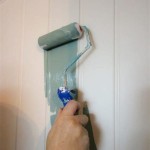How To Install An Interior Door Threshold
Installing an interior door threshold is a common home improvement task that can improve energy efficiency, reduce drafts, and create a more finished look between rooms. While it might seem daunting, with the right tools, materials, and a step-by-step approach, most homeowners can successfully complete this project. This article will provide a comprehensive guide to installing an interior door threshold, covering everything from preparation to final adjustments.
Before beginning the installation process, it is crucial to gather the necessary tools and materials. The specific items required may vary slightly depending on the type of threshold being installed (wood, metal, or composite) and the existing conditions of the doorway. However, the following list represents a generally applicable set of essentials:
- New threshold: Choose a threshold that matches the width of the door opening and the desired material and style.
- Measuring tape: Accurate measurements are essential for a proper fit.
- Pencil: For marking cut lines and reference points.
- Saw: A miter saw or hand saw, depending on the material and desired precision.
- Hammer or mallet: For tapping the threshold into place.
- Drill/Driver: For pilot holes and securing the threshold with screws.
- Screws: Appropriate length and type for securing the threshold to the subfloor.
- Level: To ensure the threshold is properly aligned horizontally.
- Wood shims (optional): For adjusting the height and leveling the threshold.
- Construction adhesive (optional): For added stability and sealing.
- Caulk (optional): To seal gaps and prevent drafts.
- Safety glasses: To protect eyes from debris.
- Dust mask: To avoid inhaling dust during cutting and sanding.
- Utility knife: For scoring and trimming materials.
Key Point 1: Preparing the Doorway for Threshold Installation
Proper preparation is paramount for a successful threshold installation. This involves removing the old threshold, cleaning the area, and ensuring a level and stable surface for the new threshold to rest upon.
Removing the Old Threshold: If a threshold is already in place, the first step is to remove it carefully. Examine the existing threshold to identify how it is secured. It may be nailed, screwed, or glued in place. Use a pry bar or a flathead screwdriver to gently lift the threshold, working along its length to avoid damaging the surrounding floor. If screws are present, remove them first. Be prepared for resistance and take care not to splinter the wood or damage the door jamb.
Cleaning the Subfloor: Once the old threshold is removed, thoroughly clean the subfloor beneath. Use a vacuum cleaner to remove loose debris, dust, and any old adhesive. A scraper can be helpful for removing stubborn residues. Ensure the subfloor is clean and dry before proceeding.
Checking for Level: Using a level, check the subfloor for any unevenness or sloping. If the subfloor is significantly uneven, it may be necessary to use self-leveling compound to create a flat surface. For minor variations, wood shims can be used to level the threshold during installation. It is important to address any irregularities in the subfloor to ensure the new threshold sits flush and provides a smooth transition.
Measuring the Opening: Accurately measure the width of the door opening between the door jambs. This measurement will be used to determine the length of the new threshold. It is advisable to measure at multiple points to account for any variations in the opening width.
Key Point 2: Cutting and Fitting the New Threshold
Precisely cutting the threshold to the correct length and ensuring a snug fit is crucial for both aesthetics and functionality. A poorly fitted threshold can lead to drafts, uneven transitions, and premature wear.
Measuring and Marking: Transfer the measurement obtained in the previous step to the new threshold. Use a pencil to clearly mark the cut lines. It is often recommended to slightly overestimate the length and then fine-tune the fit as needed. This approach provides more control and reduces the risk of cutting the threshold too short.
Cutting the Threshold: Use a saw appropriate for the threshold material. A miter saw is ideal for making precise, square cuts, especially for wood or composite thresholds. For metal thresholds, a metal-cutting blade is necessary. If using a hand saw, ensure the cut is straight and even. Take your time and avoid forcing the saw, as this can result in splintering or uneven cuts.
Test Fitting: After cutting the threshold, test fit it in the doorway. The threshold should fit snugly between the door jambs without being too tight or too loose. If the fit is too tight, use a plane or sandpaper to gently remove material until the threshold slides into place. If the fit is too loose, consider using shims to fill the gaps. Note any areas that require further adjustment.
Addressing Doorway Irregularities: Older homes often have doorways that are not perfectly square. If the door jambs are not parallel, you may need to scribe the threshold to match the contour of the jambs. This involves using a compass or profile gauge to transfer the shape of the jambs onto the threshold, then carefully cutting away the excess material. Precision in this step is important for a seamless fit.
Key Point 3: Securing and Sealing the Threshold
Once the threshold is properly fitted, the final step is to securely attach it to the subfloor and seal any gaps to prevent drafts and moisture intrusion. The method of attachment will vary depending on the type of threshold and the underlying subfloor material.
Applying Adhesive (Optional): For added stability and to help seal the threshold, consider applying construction adhesive to the underside of the threshold before installing it. Apply the adhesive in a zigzag pattern to ensure even coverage. This is particularly useful for thresholds installed over concrete subfloors.
Drilling Pilot Holes: Before driving screws into the threshold, drill pilot holes to prevent the wood from splitting and to make screw insertion easier. The size of the pilot holes should be slightly smaller than the diameter of the screws. Space the pilot holes evenly along the length of the threshold, typically every 6-8 inches.
Securing the Threshold with Screws: Drive screws through the pilot holes and into the subfloor. Use screws that are long enough to penetrate the subfloor securely, but not so long that they protrude through the other side. Countersink the screws slightly to ensure that the screw heads are flush with or slightly below the surface of the threshold. This will prevent tripping hazards and allow for a cleaner finish.
Shimming for Level (If Necessary): If the threshold is not perfectly level, use wood shims to adjust the height. Place the shims beneath the threshold where needed to raise it to the desired level. Once the threshold is level, score the shims with a utility knife and snap off the excess material. Secure the shims with small nails or screws if necessary.
Caulking the Gaps: After the threshold is securely attached, inspect the edges for any gaps between the threshold and the door jambs or the floor. Apply a bead of caulk along these gaps to seal them and prevent drafts. Choose a caulk that is paintable if you plan to paint or stain the threshold. Smooth the caulk with a wet finger or a caulk smoothing tool for a clean and professional finish.
Final Inspection and Adjustments: After the caulk has dried, perform a final inspection of the threshold. Ensure that it is level, secure, and that there are no gaps or sharp edges. Open and close the door to check for proper clearance. If the door binds against the threshold, you may need to adjust the height of the threshold or the door itself. Sanding or planing the threshold can help to create a smoother transition. The goal is to achieve a functional and aesthetically pleasing result that enhances the look and performance of the doorway.
By carefully following these steps, homeowners can successfully install an interior door threshold, improving the energy efficiency and appearance of their homes. Patience and attention to detail are key to achieving a professional-looking result that will last for years to come.

How To Remove And Replace A Threshold The Home Depot

How To Remove And Replace A Threshold The Home Depot

How To Replace A Door Threshold For Interior Exterior Doors

Replacing A Door Threshold Fine Homebuilding

Replacing A Door Threshold Fine Homebuilding

How To Remove And Replace A Threshold The Home Depot

How To Remove And Replace A Threshold The Home Depot

Your Ultimate Guide To Installing Wooden Thresholds At Home Timber2udirect

Installing Floating Floor Meets Exterior Door Threshold 1 800 Remodel

The Fast Simple Interior Door Threshold Placement Guide
Related Posts








